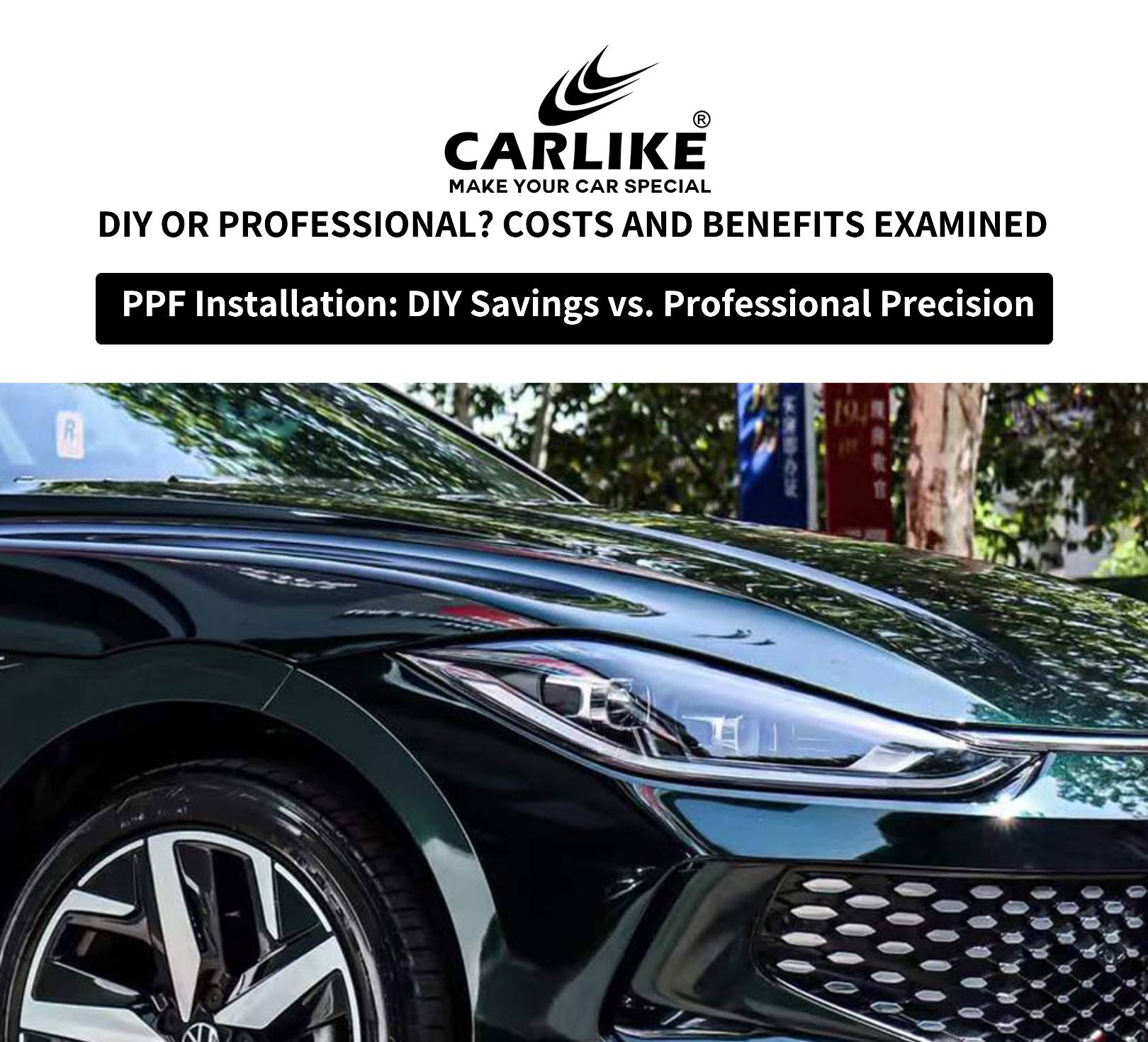Introduction
Car paint protection is essential for maintaining the aesthetic appeal and resale value of a vehicle. Exposure to environmental elements like UV rays, dirt, road salt, and bird droppings can degrade a car's paint over time, leading to fading, chipping, and rust. Effective paint protection not only preserves the car's exterior finish but also extends its lifespan and reduces the need for costly repairs and repainting.
This article focuses on comparing the costs and effectiveness of two popular paint protection methods: Paint Protection Film (PPF) and traditional wax and sealants. By examining their respective installation, maintenance costs, and protective capabilities, we aim to provide a clear understanding of which option offers better value for car owners.

Paint Protection Film (PPF)
Definition and Function
What is Paint Protection Film (PPF)?
Paint Protection Film (PPF) is a clear, thin layer of polyurethane or similar material applied to a vehicle's painted surfaces to protect against damage.
How Does It Work?
PPF adheres to the car’s surface, creating a durable barrier that absorbs impacts and prevents scratches, chips, and other damage. Some PPFs have self-healing properties that allow minor scratches to disappear with heat.
Primary Functions
1. Scratch and Chip Protection: Guards against minor abrasions and stone chips.
2. UV Protection: Shields the paint from harmful UV rays, preventing fading.
3. Chemical Resistance: Resists stains from bird droppings, tree sap, and other chemicals.
Lifespan and Durability
Lifespan
- Typically lasts between 5 to 10 years, depending on the quality of the film and environmental conditions.
Performance
- Scratch Resistance: PPF provides excellent scratch resistance, protecting the car's paint from minor abrasions and stone chips.
- UV Protection: It effectively blocks UV rays, preventing paint from fading and oxidizing over time.
- Environmental Resistance: PPF is also resistant to contaminants like bird droppings, tree sap, and road debris, maintaining the car's appearance.
Traditional Wax and Sealants
Definition and Function
Definition and Function
- Traditional Wax: A natural or synthetic product applied to a car’s paint surface to create a protective layer that enhances shine and provides a small degree of protection.
- Sealants: Synthetic products designed to bond with the paint surface, offering a more durable and longer-lasting protective layer compared to wax.
How They Work
- Application: Both are applied to the car’s paint surface and then buffed to a shine.
- Protection Mechanism: They create a barrier that protects the paint from UV rays, contaminants, and minor abrasions.
Primary Functions
- 1. Enhance Shine: Improve the visual appeal of the car by giving it a glossy finish.
- 2. Protect the Paint: Shield the paint from environmental damage such as UV radiation, dirt, and moisture.
- 3. Ease of Cleaning: Make it easier to wash off dirt and grime due to the smooth, protective layer.
Lifespan and Durability
The longevity of traditional wax typically lasts about 1-3 months, while synthetic sealants can last up to 6 months. Under various conditions, wax offers a deep shine but is less durable, requiring frequent reapplication, especially in harsh weather. Sealants provide longer-lasting protection with better resistance to UV rays, water, and environmental contaminants, making them more suitable for diverse conditions and requiring less frequent maintenance.

Cost-Benefit Analysis
Initial Investment
Paint Protection Film (PPF)
- Installation Costs: The initial installation cost for Paint Protection Film can be relatively high. It generally ranges from $500 to $2,500 depending on the size of the vehicle and the specific areas covered (e.g., full car, front only, high-impact areas). This cost includes both the material and the professional labor required to apply the film correctly.
- Factors Affecting Cost: The cost can vary based on the quality of the film, the complexity of the vehicle's surfaces, and the reputation and expertise of the installer.
Traditional Wax and Sealants
- Product Costs: The cost for traditional wax and sealants is significantly lower. High-quality car waxes typically range from $20 to $50 per container, while sealants might cost between $30 and $70.
- Application Costs: If you apply the wax or sealant yourself, there are no additional labor costs. However, if you opt for professional application, it can range from $100 to $300 per session.
- Frequency of Application: Traditional waxes generally need to be reapplied every 2-3 months, while sealants might last 6-12 months, adding to the overall cost over time.
Summary
- PPF: Higher initial cost ($500 to $2,500), one-time professional installation.
- Wax and Sealants: Lower initial cost (products $20 to $70, professional application $100 to $300), with recurring costs due to the need for frequent reapplication.
Long-term Costs
Over 7 years, the cost for waxing every 3 months can total between $1,400 and $4,200.Using sealants twice a year for 7 years can cost between $700 and $2,800.These costs can add up, especially considering the labor and time involved in regular maintenance.
Cost-Effectiveness Comparison
- 1. Initial Investment:PPF has a high upfront cost but requires minimal maintenance.Wax and sealants have a low initial cost but require frequent reapplication.
- 2. Maintenance Frequency:PPF requires little ongoing maintenance, mainly regular washing and occasional care.Wax and sealants need frequent reapplications, resulting in higher cumulative costs over time.
- 3. Long-term Protection:PPF offers superior long-term protection against physical and environmental damage.Wax and sealants provide good protection but degrade faster, necessitating more frequent upkeep.
Value for Money
Paint Protection Film (PPF)
- Better Long-term Value: Higher initial investment but provides durable, long-lasting protection with less frequent maintenance, making it cost-effective over time.
- Superior Protection: Offers more comprehensive protection against physical damage and environmental elements.
Traditional Wax and SealantsLower
- Initial Cost: Less expensive upfront, with the flexibility of DIY application.
- Higher Maintenance: Requires frequent reapplication and maintenance, which can add up in cost and effort over time.
Additional Considerations
Aesthetic Impact
Paint Protection Film (PPF):
- Gloss and Clarity: PPF provides a high-gloss finish and maintains the original paint color exceptionally well. It can also have self-healing properties that keep the surface looking pristine.
- Long-Term Appearance: PPF offers long-lasting clarity and protection, preserving the paint’s shine and color for several years with minimal maintenance.
Traditional Wax and Sealants:
- Gloss and Shine: Wax and sealants enhance the paint’s gloss and provide a deep, rich shine. They can make the paint look vibrant and freshly polished.
- Maintenance and Durability: The aesthetic effects of wax and sealants are short-lived compared to PPF, requiring regular reapplication (every few months) to maintain the desired level of gloss and color enhancement.
Protective Performance
Scratch Resistance:
- Paint Protection Film (PPF): Offers superior scratch resistance due to its thick, durable layer that absorbs minor abrasions and impacts.
- Traditional Wax and Sealants: Provides minimal scratch protection, primarily creating a smooth surface that can reduce the appearance of minor swirls but not prevent scratches.
Stain Prevention:
- Paint Protection Film (PPF): Highly effective at preventing stains from bird droppings, tree sap, and other contaminants due to its non-porous surface.
- Traditional Wax and Sealants: Offers moderate stain prevention by creating a barrier, but requires frequent reapplication to maintain effectiveness.
Oxidation Protection:
- Paint Protection Film (PPF): Excellent at protecting against oxidation as it blocks UV rays and environmental pollutants.
- Traditional Wax and Sealants: Provides good oxidation protection by creating a layer that shields the paint from UV rays, though this protection diminishes over time and requires regular reapplication.




